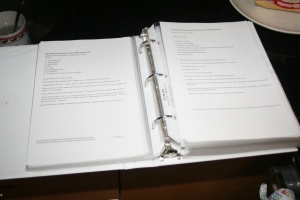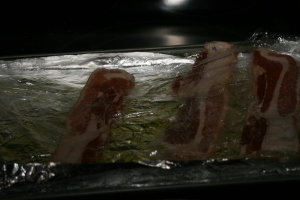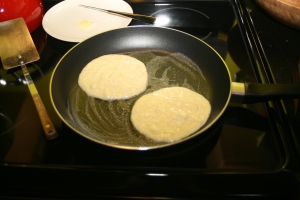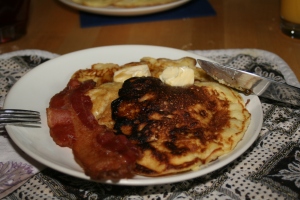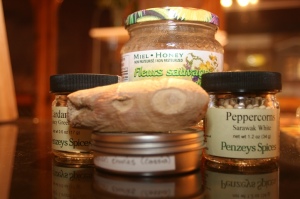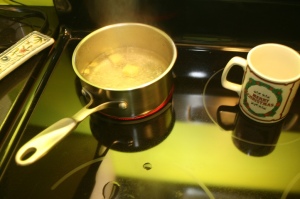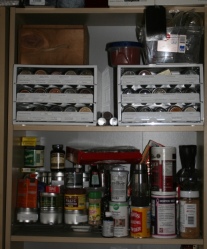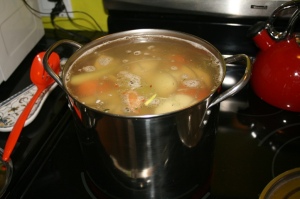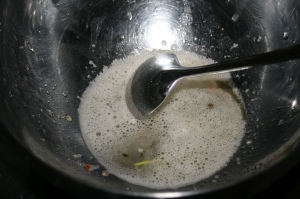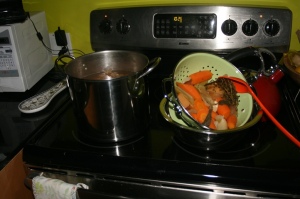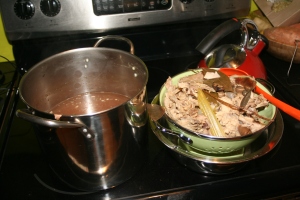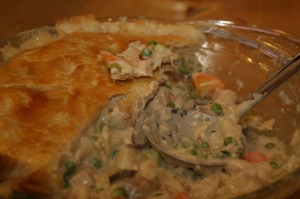Out of all of the things I’ve posted on in this blog, the copycat Stouffer’s Vegetable Lasagna post continues to be the most popular one. I get a few messages every year, asking about the recipe, even though that post is eight years old.
So here it is!
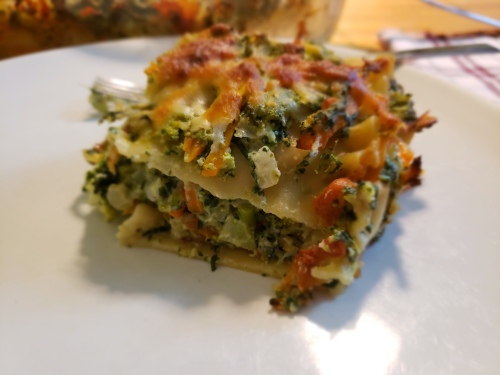
Slice of my copycat Stouffer’s vegetable lasagna
I don’t even need to follow a recipe for this anymore, and I’ve made it my own. It’s a forgiving dish. It’s been nearly a decade since I’ve eaten Stouffer’s Vegetable Lasagna, since I can’t find it where I am. For those that don’t know, this is a pre-prepared frozen creamy vegetable lasagna you get in grocery stores, either as a full tray or in individual slices, and it is delicious! I think that the store-bought version has fewer vegetables and maybe more cream/cheese sauce. Remember – it tastes yummy partly because they use the salt, butter, and cheese we’re often afraid to use as home cooks. Since I’m a mom now and I’m trying to stuff as much fresh vegetables into my family as possible, I overload the vegetables.
I do love cheese, but we eat a lot of it regularly, so that is part of the reason why I reduce the amount of cheese here. I’ve also found that, personally, even in more traditional lasagna dishes, I prefer less grated cheese. Grated cheese makes the lasagna heavier and chewier. All of those melted cheese strings hanging around everywhere get messy. It also reheats into leather that is difficult to cut and eat. I’d rather have a creamier texture here.
This recipe doesn’t have to be exact, which is why my measurements will be estimates. And it’s a copycat – I made it up myself based on the ingredient list on the back of the box and how I remembered the original tasting. Sometimes I have more broccoli, sometimes I have frozen spinach instead of fresh. Sometimes I make it using my original copycat recipe of 5 cheeses, sometimes I barely use any cheese at all. It just depends on your taste. Right now, my preference is for a ton of fresh vegetables and less cheese. The grated cheese tends to make it heavier, and chewier. But I’ll write out the two rough recipes, so you can pick which one you prefer.
“‘healthy mom’ version – more veggies, less cheese”
~3 T. butter. Ok if more.
2 T. flour
2 c. milk or half and half (10% cream in Canada)
1 Knorr bouillon cube, either chicken or vegetable, chopped
Dash onion powder
Dash garlic powder
1 garlic clove, crushed
1 small onion, diced
2 c. broccoli, diced
2 c. baby spinach
2 c. carrots, julienned
1/2 – 2/3 c. ricotta
1/4 c. parmesan, grated
1/4 c. romano, grated
1/4 c. mozzarella, grated
lasagna noodles (I use 9 for a long casserole dish)
Herb Parmesan Shake’n Bake
-maybe a tad more butter for the topping
Salt and pepper
0. Preheat oven to 375F.
1. In a big pot, cook the lasagna until it’s molto al dente, or still kind of crunchy inside but about halfway cooked. For me, that’s 6 minutes. Remove from water, run under cold water to stop the cooking process and put aside. Either put them on a plate or work quickly so the noodles don’t curl, dry out too much, or get stuck together.
2. Melt butter in a sauce pan on low heat. Can use some of that melted butter to grease the casserole dish.
3. Add onion to soften. If you don’t want to do this step, you can a) cut onion smaller or even grate it; b) use a red onion or white onion or even shallots. The red onion won’t have as much flavour as white or yellow, but it works.
4. Add flour, stirring periodically for a few minutes. Do not let it brown, but just cook out the raw taste. Add garlic.
5. Add bouillon and milk. Increase heat to medium or medium-high or high, stirring until it bubbles and thickens. Reduce heat to low. I like to cook mine down to a thick sauce. Add onion and garlic powders.
6. Meanwhile, add other ingredients to a large mixing bowl.
7. Add ricotta and salt and pepper to sauce mixture and mix it into the vegetables, preferably while it’s still hot (this helps to wilt the spinach to make it easier to mix).
8. Mix remaining cheeses in a small bowl. Reserve a bit to mix with Shake’n bake topping.
9. Layer a single layer of lasagna noodles on bottom of the pan. Add about 1/3 or so of the vegetable mixture. Add 1/2 of the cheese mixture. Add another layer of pasta and repeat. I go 3 layers, ending with a layer of pasta with a thin layer of vegetable mixture and Shake’n Bake topping (this means 9 noodles total for me). (You can also mix Shake’n Bake with a bit of melted butter to help it brown, but it’s ok to do without, too, depending on whether you want a dry topping or a browned crispy buttered topping.) Make sure the pasta is covered by at least a little of the vegetable sauce mixture, or the uncovered part will dry out and be brown and crunchy and chewy.
10. Bake uncovered 25-45 minutes, until it is bubbly. Can even go an hour. At the 40 minute mark or so, if the top hasn’t browned enough yet everything is bubbling nicely, I turn on the broiler for 2 minutes until it does become brown and the lasagna is cooked all the way through.
11. Remove from oven. Let sit for at least 10 minutes before cutting into it. It can sit for longer and still be very warm. Enjoy!
“Probably closer to the Stouffer’s version – more cheese”
~3 T. butter. Ok if more.
2 T. flour
2 c. milk or half and half (10% cream in Canada)
1 Knorr bouillion cube, either chicken or vegetable, chopped
Dash onion powder
Dash garlic powder
1 garlic clove, crushed
1 small onion, diced
1 c. broccoli, diced
1 c. baby spinach
1 c. carrots, julienned
1/2 – 2/3 c. ricotta
1/2 c. parmesan, grated
1/2 c. romano, grated
1/2 c. mozzarella, grated
1/2 c. Asiago, grated
lasagna noodles (I use 9 for a long casserole dish)
Herb Parmesan Shake’n Bake
Salt and pepper
Assembly is same as above. Use less salt, since there are fewer vegetables. Be careful to reserve enough of the vegetable mixture in order to moisten the top layer of pasta. Because you’re using fewer vegetables, you might even be able to squeeze in another layer of pasta if you want. The baking time might be shorter, since it won’t be as full.
Notes (in no particular order):
1. Fresh spinach is much better than frozen. Frozen tends to disintegrate into a messy, muddy texture while having an overpowering flavour of spinach. If that’s all you have, go for it. If using regular spinach, chop it a bit. Baby spinach doesn’t need to be chopped.
2. Feel free to change the quantities according to your taste. I like broccoli, and find that using more broccoli and carrot to spinach ratio works just as well.
3. Depending on my mood, I will sometimes do the following tweaks:
a. Use only romano OR parmesan or even ignore the mozzarella altogether. Or use Asiago instead of mozzarella. Using just one of the aged cheeses gives you a tang, but not as much depth as you get when you use both. Asiago also adds a nice roundness. I like a creamy vegetable lasagna, which means more bechamel sauce and ricotta and less grated cheese.
b. Use more milk and cook it down, so there’s a thick sauce, but you have more sauce.
c. Use more ricotta to increase creaminess.
d. Puree some of the vegetable mixture. My child is at that wonderful stage of life in which she will only ingest fruit or vegetable if it’s pureed and preferably hidden. Ah, the joys of feeding a picky eater. So I will sometimes make her her own mini lasagna using the pureed vegetables. I add the the extra back to the rest of the mix.
e. Crumbled water crackers or bread crumbs mixed with melted butter and some of the cheese as a topping. So, I actually don’t usually like breadcrumb toppings on casseroles, which is why I use Shake’n Bake here. I find breadcrumbs will often gum up the dish when it gets soggy at the bottom layer, or just get in the way of the flavours I enjoy. They also don’t reheat well in the microwave, while the rest of this lasagna does freeze and reheat quite well. So if my husband really really wants it and I’m in the mood to humour him, I will sometimes crush water crackers, mix with melted butter and some cheese as the crunchy topping. I’ve tried panko, but didn’t like it. Making your own breadcrumbs from bakery bread is much better than store-bought, because the granules are bigger and give you a better texture, but do what you want. This is your lasagna!
4. I usually use a rectangular baking dish for this, but on the very rare occasion when I don’t have certain ingredients or if I don’t want many leftovers, I use a square baking pan.
5. Can be assembled ahead of time in the morning, chilled covered in fridge, and then put directly into the oven.
6. Do make sure to save some of the vegetable mixture to moisten the top layer of pasta, or it will dry out and curl and crunch. If you run out, mixing the few drops of sauce left with some more milk will sometimes do the job, but it’s nicer to use enough of the sauce mixture.
7. Yes, you still have to salt and pepper the vegetable mixture. You’re using a ton of vegetables, and they need to be seasoned, or the whole lasagna will taste bland despite the cheese and Shake’n Bake topping.
8. Leftovers freeze really well. I cut them into individual portions and reheat in microwave for homemade frozen lasagna. In my microwave, it takes about 10 minutes to reheat a slice from frozen.
9. You can bake the lasagna longer, but the longer you bake it, the drier it will get and the pasta will become softer and even mushy. So it depends on your taste. If you underbake it, the broccoli will be undercooked and crunchy.
10. It is much better to grate your own cheeses than to buy those packages of grated cheeses. Usually, they add things to the grated cheese to keep it from sticking together in the package, and this means it doesn’t melt as nicely as without it. Plus, you get a nice workout! Unless you use a food processor. But prepacked grated cheese is what you have, it totally works. No judgement. It’s just a tad nicer to grate your own, even though it’s a pain to do it. I’ve tried the 4 cheese Italiano grated cheese mixes, which contains provolone, and will sometimes use that instead of getting individual cheeses. But for this recipe, I prefer it without provolone, which to me doesn’t go as well with the bright, sweet, savory flavours. It’s also better to have a bit more of the parmesan or romano in the mix, as it will give you more tanginess to bring out the vegetables.
11. I sometimes use even more veggies than 2 cups each. It depends what will fit inside of your mixing bowl and then baking dish. They will shrink a bit as they cook, which is why I like pouring the heated sauce over the vegetables, to help them wilt a bit so I have a better sense of what it’s going to look like out of the oven. I don’t really measure anymore. Usually one huge head of broccoli or half a Costco package of florets is perfect, washed, peeled, and chopped well. A big tray of baby spinach, like the kind you get at Costco. And maybe 2 big carrots. A big onion (I like onion).
12. I have cut into a hot lasagna fresh out of the oven, but it won’t hold together and is too hot to eat right away. It will hold its shape better for cutting and presentation if you wait for it to cool down, usually about 10 minutes.
13. I’ve even tried using parmesan from those shaker containers, like Kraft or President’s Choice, but those almost powdered parmesan cheese sprinkles don’t melt as well as grated. I’d recommend using either grated, or grating your own rather than using canned cheese sprinkles. But if that’s all that you have, go for it.
14. The pasta matters. I prefer Barilla lasagna for this, or sometimes a wholewheat one. Use what you want, but be sure you cook it only until it’s a bit bendy but not yet al dente. Cheaper pasta won’t have a nice texture. Sometimes different brands are thinner, so you have to do 4 lasagna noodles to a layer instead of 3.
15. Don’t worry about being a purist and doing everything by hand. Use the food processor to jullienne and chop the vegetables if you prefer.
16. I use full-fat milk or even 10% cream here, as well as full-fat ricotta and cheeses. I’ve tried with reduced fat, but I myself prefer full fat. Do as you like, though.
Hope this was helpful. Enjoy! Share pics of how it turned out!
